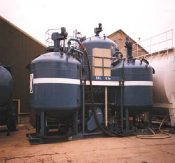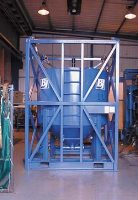01-02_technology-staff_1.htm (Feb-2001)
TECHNOLOGY AT WORKPremixed cement slurry for North Sea P&A operationsDan Daulton, Region Engineer, BJ Services Co., International Operations Houston, and Sarah Gibson, Project Engineer, BJ Services Co. (UK) Ltd., Cementing Services, Aberdeen BJ Services has developed and applied a new cement slurry that has a key feature of being premixed such that it can be stored and transported to sites that have no mixing facilities. This and other advantages of this relatively new product, and an application example in a plug and abandon project in the Southern North Sea are presented here.
Product advantages. Liquid Stone is a delayed-setting, premixed cement slurry. Since its initial development in 1996, it has been used in hundreds of applications worldwide. The product differs from standard Portland cements in its ability to be mixed days, weeks or even months prior to use. A proprietary set of plasticizers and suspending / set-delay chemistry provides the engineer a versatile, dependable cement slurry with excellent quality control. Due to the slurry being premixed and sampled well before application, correct density, stability and routine cement-slurry-performance characteristics, such as fluid loss, fluidity and compressive strength are tracked from the initial mix date. Cement lab test samples are of the application mix, which are labeled and evaluated until the batch is pumped, thus providing improved quality assurance. Additionally, use of the product provides the options of not requiring cement mixing equipment onsite. This is a tremendous advantage when working in environmentally sensitive and / or remote areas, with restricted onsite equipment capabilities. The advantages of utilizing this technology are:
Of course, all of these advantages come with some cost and, on the surface, the new slurry does appear more expensive than "regular" cement. However, when considered in the context of less equipment rental charges, less rig time wasted rigging up and down, reduced manual handling and improved health / safety factors of the job, many customers consider it an investment. North Sea applications. The advantages noted above are what led Shell Expro Southern North Sea, Gas Supply Group, to consider the premixed product as a solution to its plugging problem on an established platform with no cement mixing equipment and limited crane capacity.
This area of the North Sea has several unmanned production platforms which require plug / abandonment services These installations either have no rig-site mixing or bulk-handling equipment available to facilitate typical cement mixing operations, or this equipment has been decommissioned to avoid costly routine maintenance. Therefore, cementing operations require mobilization of cement mixing and pumping unit, hydraulic power pack, portable bulk container(s) of the liquid additives and, possibly, a 100-bbl batch mixer for rig-site slurry preparation. Alternatively, the operator can mobilize a number of Liquid Stone transport tanks (depending on volume required), a 100-bbl batch mixer, centrifugal pump and hydraulic power pack. The latter option reduces logistical concerns associated with dry-powder cement transfers, chemical tracking, handling, storage and excess product return. This option also eliminates concerns over what may be the weak link in the mobilization plan – platform-based cranes. Many of these, if operational at all, are limited to less than 10-mt lift capacity. This situation creates a safety risk and requires multiple heavy lifts of at least two, if not three, skid-style, modular pieces of cementing mixing and pumping equipment. P&A case history. BJ Services in Great Yarmouth, England, provided the new product for a plug and abandonment project in the Southern North Sea. The first well had three plugs set at 6,000 ft, 3,800 ft and 2,980 ft. A total of 180 bbl of slurry was manufactured at densities of 14.6 and 15 ppg. The product was transported offshore with four, 10.1-mt (10 ft x 8 ft) tanks, three, 8.1-mt (6 ft x 8 ft) tanks and one, 10.5-mt (8 ft x 8 ft) prototype, fit-for-purpose Liquid Stone transport tank, see photograph. Once on the platform, the required number of transport tanks were emptied into a 100-bbl batch mixer, based on predetermined job volumes. The slurry was re-homogenized and treated for final placement. Lab testing of the premix suggested activator concentrations of 2.0 gpb LSA-1 at 118°F for the lowest plug; l3.0 gpb of LSA-1 for the 80°F plug, and 3 gpb of LSA-1 for the 60°F plug. Test results are shown in the accompanying table.
Each plug was pressure tested as follows: Plug 1: 6,000 ft, 2,000 psi after 15 hr; Plug 2: 3,800 ft, 2,000 psi after 12.5 hr; and Plug 3: 2,980 ft, 2,000 psi after 18 hr. Once the slurry was activated, it was pumped into
position via the casing, with seawater as a displacing fluid. The plugs were tagged after placement to ensure
proper depth. Demobilization of all equipment taken to the unmanned platform completed the operation. Several
additional applications in the Southern North Sea on other installations are now under consideration.
Acknowledgment BJ Services would like to thank Shell Expro for their kind permission to publish this article. |
||||||||||||||||||||||||||||||||||||||||||||||||||||||||||||||||||||||||||||||||||||||||
- Applying ultra-deep LWD resistivity technology successfully in a SAGD operation (May 2019)
- Adoption of wireless intelligent completions advances (May 2019)
- Majors double down as takeaway crunch eases (April 2019)
- What’s new in well logging and formation evaluation (April 2019)
- Qualification of a 20,000-psi subsea BOP: A collaborative approach (February 2019)
- ConocoPhillips’ Greg Leveille sees rapid trajectory of technical advancement continuing (February 2019)




